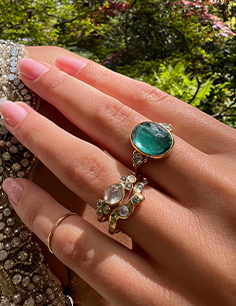Why should I consider a recycled Diamond?

Ever heard of the term “Diamonds are forever”? This phrase was coined because diamonds are one of the hardest naturally occurring substances on the Earth, which makes them perfect contenders for recycling as they can be used more than once without virtually any show of wear. The idea of recycling one's diamond jewelry isn’t a new concept.
Historically diamonds have always been recycled, as individuals have sold their jewelry. However there has been an uptick in this trend the past few years, as shoppers are more concerned and aware of the topic of sustainability. If sustainability is important to you, continue reading to see if a recycled diamond is the right choice for you for the custom handmade ring of your dreams!
What are recycled diamonds?
Recycled diamonds are diamonds that are either antique, pre-owned, estate or a family heirloom, and are ready to be repurposed into another piece of jewelry. Because they are reutilized after a prior purchase, these diamonds require no new mining, making them a responsible choice.
Is there a way to know where my recycled diamond is originally from?
Since recycled diamonds are continually being repurposed from previously owned pieces, remember that when purchasing a recycled diamond, the source may be completely unknown. In the event that the diamond was likely not sustainably sourced, it is just considered sustainable because it’s been reused. It also goes to show why diamonds are so special. A material like a diamond can retain its value for hundreds of years.
Are recycled diamonds rare?
Diamond cutters cut the majority of newly mined diamonds into round brilliants because this shape is the most popular of all the diamond cuts. For those of you looking for something a little less traditional, recycled diamonds often come in rare vintage cuts no longer on the market. If you’re lucky enough to find one before it’s recut into a round brilliant, you can own something much rarer than a conventional diamond, you can hold a piece of history in your hands! Each of the antique cuts are charming in their own way.
Old mine cut diamonds date back to the 18th, an era when diamonds were cut and polished by hand. Famous for their distinctive proportions, unique fire and noticeable culet, old mine cut diamonds are enjoying something of a renaissance at the moment. It was either square or rectangular with slightly rounded corners. Their large open culet, bruted girdles, and large depth percentages really made them sparkle under candlelight. Today, true old mine cut diamonds are more difficult to find than Old Europeans.
Old European Cuts gained its popularity during the 19th into the early 20th Century. This new round diamond cut was rapidly embraced by diamond cutters in Europe, thus coining the term the European cut; a term which indicates stones with round outlines, reasonable symmetry, octagonal table facets, deep pavilions, high crowns, short pavilion bezels and an open culet. They exhibit great fire and broad flashes of sparkle demanding the viewer’s attention be drawn into the diamond.
As for transitional cuts, several older round brilliants were cut between the 1870s and the 1940s, and because some served as transitions between older and the more modern styles, some trade professionals call them “transitional cuts.” Older gems typically show larger face-up and easily distinguishable patterns of light and dark.
All are very rare in comparison to modern diamonds of today and they have all been out of production for about a century. Old Mine Cuts, Old European Cuts, and Transitional Cuts have now become a collector’s item.









